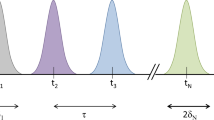Abstract
Specific features of the self-organization of various complex systems at the micro-, meso-, and macro-levels are investigated, taking environmental conditions into account. It is shown that the impact of the environment on a system in the process of self-organization can be modeled by relying on a four-digit measurement logic associated with the probabilities of type I and type II errors arising during comparisons. Harmonic self-organization stems from the quantization of actions, allowing measurement-action matrices to be transformed into quantum measurement matrices characterized by a parameter of the order of generalized golden ratios. Patterns of harmonic self-organization taking the form of complexes of elements in matrices are used to construct a quantum complex scale for classifying elements. Examples of manifestations of harmonic self-organization are considered.


Similar content being viewed by others
References
G. Nicolis and I. Prigogine, Exploring Complexity, Piper-Verlag, Munich, Germany (1987).
G. G. Malinetsky, V. E. Voitsekhovich, I. N. Vol’nov, et al., Beauty and Harmony in the Digital Age: Mathematics – Art – Artificial Intelligence. The Future and the Humanitarian and Technological Revolution, LENAND, Moscow (2021).
S. L. Chernyshev, L. K. Isaev, and A. D. Kozlov, Measur. Techn., 63, No. 8, 602–609 (2020), https://doi.org/10.1007/s11018-020-01829-6.
B. B. Kadomtsev, Dynamics and Information, Uspekhi Fiz. Nauk, Moscow (1997).
S. L. Chernyshev and A. S. Dmitriev, Model of Nonspecific Influence of the Environment, Preprint IRE RAN No. 4 (604) (1995).
S. L. Chernyshev and L. S. Chernyshev, Measur. Techn., 49, No. 12, 1171–1178 (2006), https://doi.org/10.1007/s11018-006-0256-8.
L. K. Isaev and S. L. Chernyshev, “Based of the scale theory classification of the elements with defined sequential numbers,” Nelin. Mir, 5, No. 10–11, 705–711 (2007).
S. L. Chernyshev, Modeling and Classification of Nanostructures, LIBROCOM, Moscow (2011).
S. L. Chernyshev, Figurate Numbers: Modeling and Classification of Complex Object], KRASAND, Moscow (2015).
A. S. Chernyshev and S. L. Chernyshev, “The manifestation of har monic self-organization in the economy,” Zakonodat. Prikl. Metrol., No. 6, 40–44 (2021).
A. S. Kholevo, Introduction to Quantum Theory of Information, MTsNMO, Moscow (2005).
L. D. Fadeev (ed.), Mathematical Physics. Encyclopedia, Bolshaya Ross. Entsiklopediya, Moscow (1998).
M. B. Mensky, Quantum Measurements and Decoherence: Models and Phenomenology, Kluwer Academic Publ., Dordrecht (2000).
S. S. Sysoev, Introduction to Quantum Computing. Quantum Algorithms: Teach. Aid, Izd. SPbU, St. Petersburg (2019).
A. P. Stakhov, Introduction to Algorithmic Measurement Theory, Sov. Radio, Moscow (1977).
E. M. Soroko. Golden Sections, Processes of Self-Organization and Evolution of Systems: Introduction to the General Theory of Harmony, LIBROCOM, Moscow (2012), 4th ed.
V. S. Ivanova, Introduction to Interdisciplinary Nanomaterial Science, SAINS-PRESS, Moscow (2005).
I. V. Prangishvili, Entropy and Other System Patterns: Issues of Complex Systems Management, Nauka, Moscow (2003).
P. Panchadhyayee, R. Biswas, A. Khan, and P. K. Mahapatra, J. Phys. Condens. Matter, 20, No. 27, 275243 (2008), https://doi.org/10.1088/0953-8984/20/27/275243.
O. Postavaru and A. Toma, Chaos, Solitons & Fractals, 154, 111619 (2022), https://doi.org/10.1016/j.chaos.2021.111619.
S. L. Chernyshev, Measur. Techn., 50, No.12, 1234–1239 (2007), https://doi.org/10.1007/s11018-007-0231-z.
S. L. Chernyshev and L. S. Chernyshev, “Superlattices and figurate numbers in the model of signal processing system and colour perception,” Zh. Radioelektr., No. 12, 18 (2013).
Author information
Authors and Affiliations
Corresponding author
Additional information
Translated from Izmeritel’naya Tekhnika, No. 3, pp. 9–16, March, 2022.
Rights and permissions
Springer Nature or its licensor holds exclusive rights to this article under a publishing agreement with the author(s) or other rightsholder(s); author self-archiving of the accepted manuscript version of this article is solely governed by the terms of such publishing agreement and applicable law.
About this article
Cite this article
Chernyshev, S.L., Chernyshev, A.S. General Problems of Metrology and Measurement Technique Metrological Aspects of Harmonic Self-Organization. Meas Tech 65, 157–165 (2022). https://doi.org/10.1007/s11018-022-02063-y
Received:
Accepted:
Published:
Issue Date:
DOI: https://doi.org/10.1007/s11018-022-02063-y




